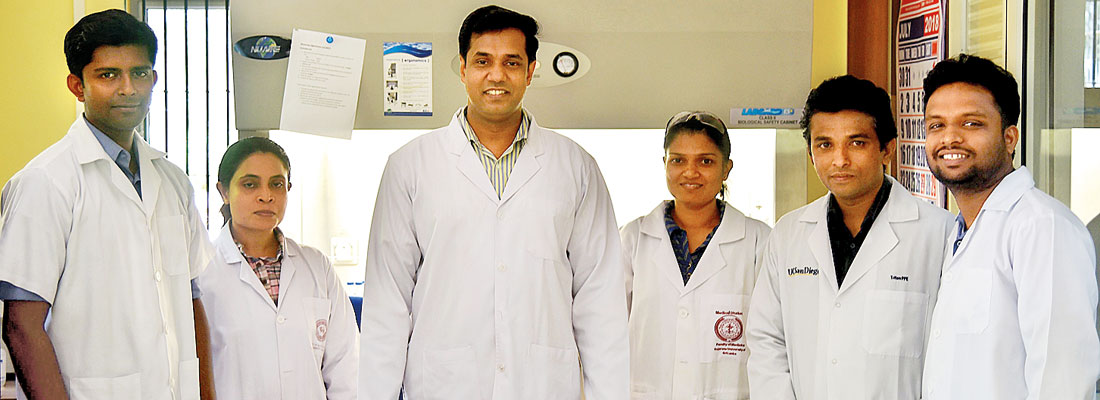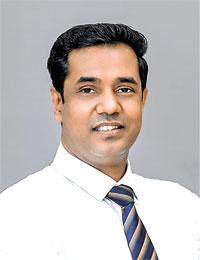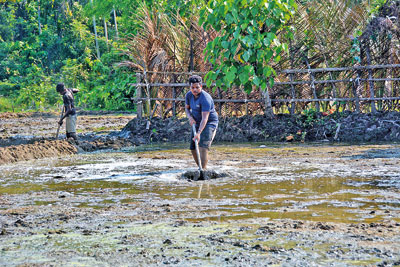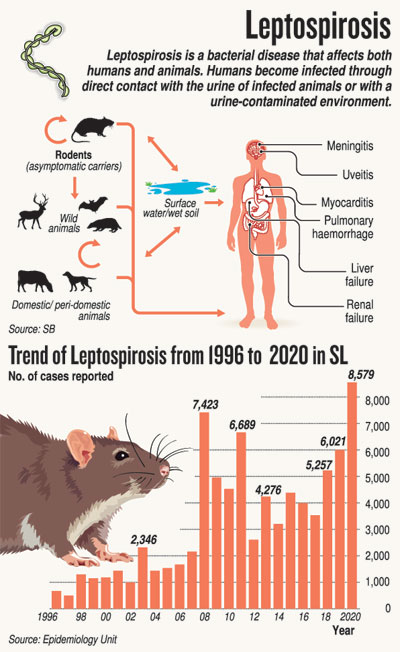News
Rajarata University researchers make strides in Rat Fever study

The team of researchers at the Leptospirosis Laboratory of the Faculty of Medicine and Allied Sciences, Rajarata University (from left) Shalka Srimantha, Chamila Kappagoda, Prof. Suneth Agampodi, Dr. Dinesha Jayasundara, Indika Senavirathna and Dr. Janith Warnasekara (Nirmani de Silva is not in the photo)
As Sri Lanka battles the COVID-19 pandemic set off by a spiked virus, another epidemic has been holding the agricultural heartland of the country in its vice-like grip.
This is the spiral-shaped bacteria spreading Leptospirosis or Rat Fever, usually the poor person’s disease for which Sri Lanka is a ‘hotspot’.
Even in these challenging times though, diligent medical researchers based in Anuradhapura have not abandoned the humble farmers facing the rampaging Leptospira bacteria.

Prof. Suneth Agampodi
Their research has not only taken the knowledge of Leptospirosis to a new level but also brought much credit to Sri Lanka.
The findings include identifying 12 ‘novel’ clonal groups of Leptospira causing illness in people in different regions in Sri Lanka and the complete genome sequencing of 10 Leptospira strains.
The core research team in Sri Lanka is led by Prof. Suneth Agampodi, Founder Professor & Chair of the Department of Community Medicine, Faculty of Medicine and Allied Sciences, Rajarata University and includes Dr. Dinesha Jayasundara, Indika Senavirathna and Dr. Janith Warnasekara of the Leptospirosis Research Laboratory.
Supported by a grant from the National Institutes of Health (NIH), United States of America, the Sri Lankan research is part of a multi-country project led by Prof. Joseph M. Vinetz of the Yale University.
Before focusing on their achievements, Prof. Agampodi says that they studied blood cultures obtained from 1,192 patients from June 2016 to January 2019, from 14 districts representing all nine provinces. They identified 25 “isolates” (a culture of micro-organisms isolated for study).
The patient profile was: 985 males & 207 females; the average age was 43 years; and 96% were inpatients & 4% outpatients.
The research in Sri Lanka has brought forth:
- 12 Novel clonal groups of Leptospira, representing four species, infecting humans in different settings. The four species identified in this prospective study covering the full range of climatic zones, geography and clinical severity are: L. interrogans, L. borgpetersenii, L. weilii and L. kirschneri.
L. borgpetersenii had been found only in the dry zone and L. weilii only in the wet zone.
Acute kidney injury and cardiovascular involvement had been seen only with L. interrogans infections; while thrombocytopenia (a low blood platelet count) and liver impairment had been seen in both L. interrogans and L. Borgpetersenii infections.
These findings have been published in the prestigious journal ‘PLOS Neglected Tropical Diseases’ in March.
Pointing out that Leptospirosis has been found to cause wide and varied illness – renal failure in some patients; liver involvement, red eyes and discolouration of the skin in others; and in another group major lung involvement which leads to death, Prof. Agampodi says that with a correlation being established between the Leptospira species and the organs those specific species affect, doctors would be able to save more lives.
Complete Genome Sequencing
Another first for the team is performing the Complete Genome Sequencing of 10 strains of Leptospira – three strains of L. interrogans and seven strains of L. borgpetersenii.
It adds another feather to the cap of the major research that Prof. Agampodi has been conducting on this disease – historically referred to as the ‘red-eyed demon’ – since the early 2000s. This research had been published in the ‘Journal of Genomics’ last year.
Sequencing is a laboratory technique used to determine the exact sequence of bases (A, C, G and T) in a DNA (deoxyribonucleic acid) molecule. The DNA base sequence carries the information a cell needs to assemble protein and RNA molecules. DNA sequence information is important to scientists investigating the functions of genes.
Genetic mapping or linkage mapping, meanwhile, provides clues as to which gene in Leptospira causes human disease by penetrating cell walls and destroying tissue.
“Such mapping in the laboratory setting allows us to zero-in on Leptospira’s specific genes and their functions,” explains Prof. Agampodi.
Optimizing the MAT panel
Meanwhile, the team has also dabbled in optimizing the microscopic agglutination test (MAT) panel for the diagnosis of Leptospirosis, which findings have been published in the journal ‘PLOS Neglected Tropical Diseases’ on July 1.

Even in these challenging times though, diligent medical researchers based in A'Pura have not abandoned the humble farmers facing the rampaging Leptospira bacteria. Pic by Indika Handuwala
Referring to the paper ‘Optimizing the microscopic agglutination test
(MAT) panel for the diagnosis of Leptospirosis in a low resource, hyper-endemic setting with varied microgeographic variation in reactivity’, Prof. Agampodi explains that the World Health Organization (WHO) recommends the use of 24 antigens in the panel.
“This is very costly for low-resource settings such as Sri Lanka with a high prevalence of Leptospirosis,” he points out, adding that his team has come up with a MAT panel with 13 antigens and similar efficacy. This work is ongoing and further optimization will be done using the local isolates.
The studies of the Anuradhapura team have not included patients from areas such as Galle and Matara in the south in whom there is a high incidence of lung involvement and Prof. Agampodi hopes that more researchers would look into these important areas.
| Largest outbreak of poor person’s disease in 2020 “How many are aware that we had the largest reported outbreak of Leptospirosis in Sri Lanka last year (2020), according to Epidemiology Unit data,” asks Prof. Suneth Agampodi. With the pandemic taking a high toll, both in the form of disease and death, other diseases tend to be put on the backburner. But these diseases may have a higher case fatality rate, he laments, focusing on Leptospirosis. The data are disturbing: Leptospirosis is estimated to affect 52 per 100,000 persons with 730 deaths annually. First documented in the country in 1953, in more recent times 7,423 cases were reported in 2008 by the Epidemiology Unit. However, Prof. Agampodi is a firm believer that the true numbers affected by Leptospirosis may not be reflected in national data due to under-reporting in public, private and traditional health sectors; lack of early diagnosis; and being misdiagnosed as many other diseases mimic it. In 2020, Leptospirosis cases notified to the Epidemiology Unit were 8,579, the highest annual number up to then. Prof. Agampodi argues that based on previous calculations on disease under-estimation, this number may have exceeded 12,066 in 2020, with around 845 deaths. He points out that one reason could be that with Colombo and Gampaha being high-risk areas for COVID-19, these districts which have usually reported high numbers of Leptospirosis cases in the past 10-15 years, may not be showing true data. Prof. Agampodi would certainly know what he is talking about because he has been peering at this bacteria and disease through frozen samples in 2003 in Kandy, the major outbreak of 2008, the cases which followed the flood in Anuradhapura in 2011, those who caught the bug after whitewater-rafting at Kitulgala in 2012 and more.
| |


